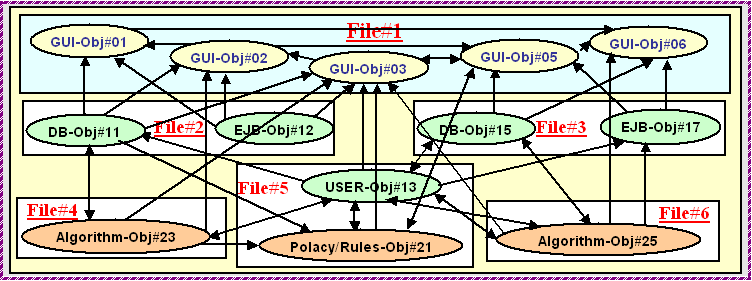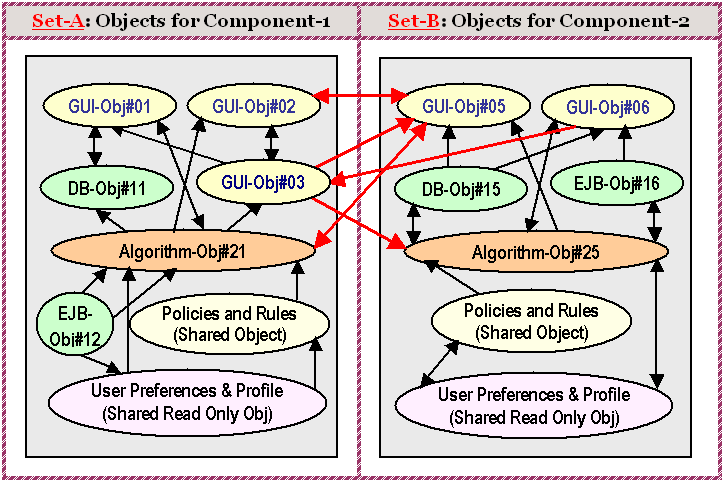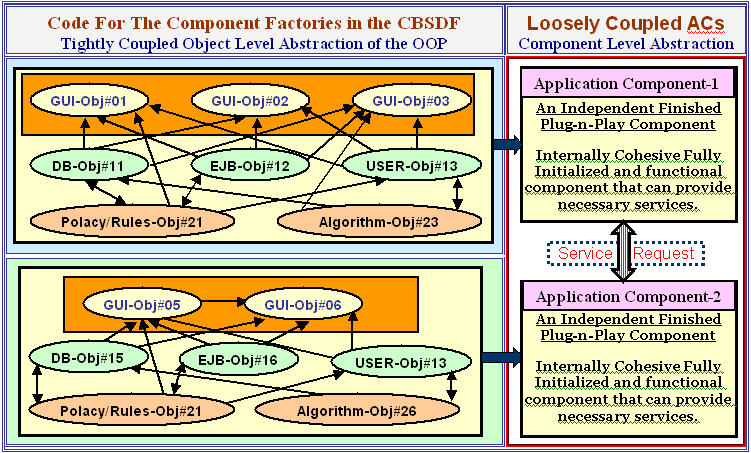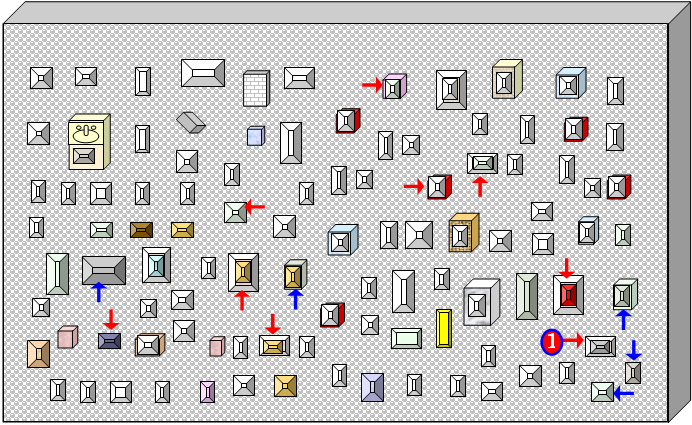Computer
analogy: OOP verses Loosely-coupled components
|
Each application contains many 'loosely coupled' components. However the OOP (Object
Oriented Paradigm) don't partition the application into physical “loosely coupled” parts.
That is, the OOP don't physically separate the 'Loosely coupled' parts and
physically encapsulate each loosely-coupled component in a unit (e.g. CF) to preserve its
autonomy, for example to operate on the unit autonomously. Just recognizing their existence and
consciously reorganizing the application into “loosely coupled” parts would more than double
the average software developer’s productivity.
|
|
Many Objects are used to build each “loosely coupled”
part. Hence the “loosely coupled” parts are higher-level abstraction. Also each “loosely coupled” component needs minimal coupling code to include into the application.
All the applications contain many “loosely coupled” components, but unfortunately
often it is not possible to leverage them in the traditional programming paradigms such as OOP.
|
|
For example, assume
a small application has only two parts. One ends up creating set of files and each of the files contains Object for each
component. But, if you study the interactions between these two components, they may have about 10 to 15 lines of coupling code, with out any
conscious optimization. With very little effort or slight redesign, it is possible to reduce the coupling code to about 5 lines.
|
Figure#1 |
 |
|
To
study this, virtually partition the Objects into 2 sets on a paper: Set-A &
set-B (see FIG#2). Here, each set contains Objects used for building each component. Then map the interactions (Red
Arrows) between the two groups and count lines of code.
|
|
Figure#2
| |

|
|
Each black-arrow shows the dependencies between the Objects used for building each component. The red-arrows shows dependencies between the components (i.e. Interactions between any two Objects, where each Object belong to two different components).
Even each 'Component' is not optimized consciously to minimize its
couplings, most "Components' would have very little real-couplings with rest of the
parts as shown in FIG#2.
|
|
However, the OOP do not encapsulate each Object-group to maintain physical separation between the Object-groups (i.e.
component-abstraction). Hence, to separate the component from the application, it requires lot of manual-effort and knowledge about the internal design of each component, such as, to identify each of its Objects, interactions between these Objects and with external Objects.
|
|
This is kind of like, putting both Graphics-card and network card on same board (e.g. PCB- Printed Circuit Boards) by combining all the chips/devices for both parts (See software equivalent in FIG#1, where each Object is a device). How can a new person replace or remove the network card alone, with out identifying and removing each device used for supporting the services offered by the network-card?
|
|
Now imagine, if one builds the entire computer like that. All the chips/devices for all the plug-in parts of the computer (e.g. Hard-drive, mother-board,
power-supply, floppy-drive and CD-player etc.) are placed on a very large main Printed-circuit board.
|
|
Figure#3
|
 |
|
Even a trivial
conscious design effort could reduce each
'loosely coupled' part's couplings to about two services-level interfaces (which
is shown in the right side of FIG#3).
|
|
This is just one-level of hierarchy. For example, the hard-drive again contain many subcomponents, where some subcomponents (e.g. Motor that spins the magnetic disks) contain many subcomponents
of their own. If the Motor contains 10 devices, one needs to put the 10 devices on the same main board. The subcomponents (i.e. devices) of the Motor may be placed next to the devices for the CD-player. Again one of the subcomponent of the Motor may have 5 devices, each of which needs to be placed on the same large board. Notice
the 'component-hierarchy' in the complex products.
|
|
This successive decomposition of subcomponents into basic devices makes its physical structure flat. If all the
basic devices for each of the computer-part are placed on a large board, how any one can remove a large part?
Please remember each part may contain subcomponents, which in turn contain many
device? If one places all the basic
devises on large flat-board, it is unlikely or even hard to make any conscious effort to minimize
the dependencies (e.g.
Red-lines in FIG#2) between the 'parts'.
|
| |
|
Likewise,
for three large 'parts', the physical structure of the Objects end up as shown Fig#15
in the webpage (while they should be organize as shown in Fig#17)*.
So, in the OOP, the physical structure of the Objects
end up flat. In such
flat structure, to remove or replace a large part, one must remove
one tightly-coupled object (or device) at a time. This requires lot of knowledge and
expertise, and yet prone to errors.
|
|
*Important
Figures:
You must see how spaghetti-code start accumulating even for 2 or 3 components. ('Physical
structure of code beginning to stop reflecting the
design-intent' (more later)).
Even a medium-size application contains hundreds of components, each of which
contains one or two service-interfaces. Hence, in large applications all these
Object-level dependencies buried under a million lines of code.
OOP does not make any distinction between
these two kinds of dependencies (represented by black arrows and red arrows).
These dependencies together constitute nearly 50% of total application code. If we could make the distinction, the red arrows would constitute about 4% to
7% of the code. A conscious design not only reduces them to less than 2% of the
code but also makes it easy to comprehend high-level code.
|
|
Although,
design document may say there exist some sort of virtual hierarchy, the physical
structure of the Objects is undeniable flat (spaghetti code). How can new recruits
comprehend such 'highly subjective'
imaginary hierarchy? It is too complex to predict what soft of effect a small change
would have on the other parts. To make even a small change, he must comprehend internal design and interfaces of
many objects.
|
|
Each large application contains many such components, and subcomponent hierarchies. Pioneer-soft invented an elegant way to
encapsulate each component in a Replaceable
Container, while preserving the successive subcomponent hierarchies.
|
|
Pioneer-soft argues that, in the OOP-style development, we are building many basic devices (i.e. Objects) and placing all of them on a large board (e.g. FIG#1) to build computer. Every one must agree that, it is better to build the computer by partitioning the one large board, into many “loosely coupled”
physical-parts (e.g. FIG#3), one for Graphics-card, one for Hard-drive and another for network-card etc.
|
|
Is
it hard to believe, the plug-n-play physically-encapsulated parts can cut 70% of total costs? The costs include long-term maintenance. Since updates
take less time, less risky, making applications easily adoptable and help increase user productivity.
|
|

|
|
Figure#4:
Full System Board after plugging-in all the Parts/Devices
|
|

|
|
Each of the top-level components (e.g. Part-1) are plugged into the "System Board". The Part-2 is a subcomponent of the
top-level Part-1. The Part-3 is a subcomponent to the Prat-2, where Part-2 itself is a subcomponent and so on for
five layers until Part-5. In this hierarchical configuration any
part at any level can be removed, or replaced with a compatible
part in seconds (Click here for figs). Removing any part (e.g. Part-2) effectively removes all its subcomponents.
|
|
| |
|
Figure#5:
If all the devices are places flatly on the Board
|
|

|
|
If it were not possible to build as an hierarchy of Replaceable-parts
(very-useful-link), the devices must be flatly spread on the board. Then to replace each part, one must identify each of its devices (e.g. marked by red-arrows) and replace one device at a time. It is very complex to replace each device/object, since it is likely not designed as an replaceable part, so tightly coupled with other devices/objects. If the computer-board is designed an an OOP applications, most devices are not be designed to be replaceable. Each device (e.g. marked by '1') for a part (e.g. Hard drive) may end up tightly coupled with the devices for other parts (e.g. marked by blue-arrows). To replace a device, one must comprehend these couplings and must redesign interfaces of those devices/Objects.
Although
Hard Drive may have 100 subcomponents/Objects, it can be removed in minutes,
because it physically encapsulates all its subcomponents and also it is loosely
coupled with other external components (with in the computer). When the whole
product is build by assembling such loosely coupled swappable modules, the total cost of the
product will be about 20% more than the total cost of all the swappable modules goes into it. This is true for Automobiles and Computers. How much it
costs for Dell just to assemble each PC? Why the total cost of ownership of
large software applications would be 2000% or 20 times more than the cost of all
the Objects goes into it?
|
|
|
|
Today network-card can be replaced in minutes, instead of going through risky, uncertain and error-prone process
for identifying each basic device (i.e. Objects) of the network-card and removing it. If
all the devices (i.e. Objects) for each part
cannot be encapsulated in a replaceable-container, they likely be scattered at many
places on the large main-board. Hence, to remove the part, one must remove each of its devices and resolve
all dependencies (e.g. of each device has with other devices, each of which may be used as a subcomponent for
other parts such as Graphics-card or Hard-drive).
|
|
Is
it possible for the computer-makers to avoid crisis, similar to the software-crisis that the software makers are facing, if they
also can't build hierarchies
of swappable modules (i.e. assemble small devices to build larger and larger
Loosely coupled parts)?
|
| |
|
Please
assume, certain constraints preventing computer-makers from assembling basic devices
to build plug-n-play parts (e.g. Hard-drive or Network-card). If a system has
only two components, the constraints will force him to place all the devices
for the both parts on same board (i.e. merge the devices for both parts and
spread them flatly on the board as shown in Figure#1-- Assuming Objects
represent electronic-devices).
Please remember,
he is not doing by choice, but being forced to merge all the devices and scatter
on the same board. Such constraints also will prevent him from grouping the devices for each
part into a separate section of the board.
If he can put on separate sections, then nothing prevents him from cutting the
board into 2-pieces and connect using a plug-with-pins and a socket (pins shown in
Fig#2 in red). If a system has only two parts, this device-scattering
is not a big problem. But, the complexity grows exponentially as he adds devices
for larger and larger component-hierarchies.
For
example, if he needs to add a large new part (e.g.
Hard-drive), he will be forced to add many devices (for it and its subcomponents).
Since he cannot physically group the devices for the new part, he
will be forced to place at least 1 or 2 device at different location on the board. Hence, in effect he scattered the devices for each part (e.g. DVD-player or Hard-drive) among thousands of devices (belong to
the other parts).
Then how can he replace a
large part, such as, Hard-drive? Can you see the striking similarity to the problem the software
developers are facing? The developers can't encapsulate the Objects (i.e. devices for the ‘loosely-coupled’ software
parts) in a "swappable module" either. This forcing them to scatter at least
one or two Object (i.e. device) for each part among thousands of Objects (devices
for other software parts).
Furthermore,
the software components have no interface standards. So, it is kind of like each
device is designed for different frequencies and voltages (e.g. 3V, 5V, 7V or
9V). To understand the true complexity, we must consider the basic
components for the computers, where many of them are tightly coupled parts (i.e.
silicon, plastic etc.) and not loosely coupled parts (e.g. devices).
|
| |
|
Preserving physical representation of the design-intent in the code-implementation
The
software designers (or human beings) often think in terms of ‘loosely coupled’
components. They design the
products in terms of components and their loosely coupled services.
Unfortunately, OOP is not able to preserve the intent by encapsulating the
Objects to maintain physical separation of each component in the code. Hence the
code failed to mirror/reflect design-intent. Isn't the intent 'scattered' in the
implementation? in the
implementation?
Physical structure of the code must reflect the
design-intent. We must be able to physically preserve the design intent in the implementation. Also we must be able to maintain both of them in-sink all the time, during the maintenance cycles.
The product-makers successfully accomplished that by employing
'component-hierarchies'. Each part and its interfaces represent design-intent.
(e.g. engine, Hard-drive or CD-player).
|
|
